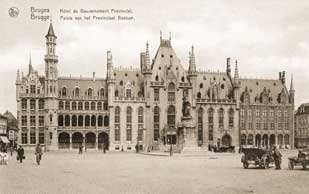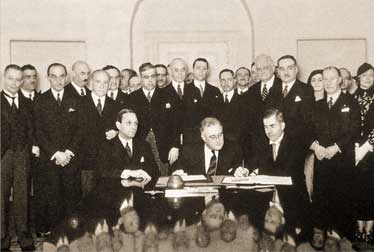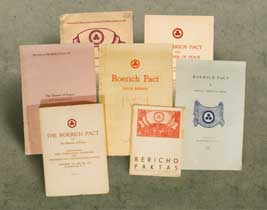| printer friendly | |||
|
|||
The Pact Project acquired world fame. In all countries, societies for the Pact support were created. Romen Rolland and Bernard Shaw, Rabindranat Tagore and Thomas Mann, Albert Einstein and Herbert Wells supported N. Roerich’s idea .
In the hall wall-cases, documents and photos telling about the Pact promotion and establishment are exhibited.
 | |
| Photograph of the Cathedral of the Holy Blood in Bruges |
 | |
| Delegates of the Second International
Conference dedicated to Roerich’s Pact. Bruges. August 1932. |
In August 1932, the Second International Conference dedicated to the Pact for protection of cultural values took place. An exhibition of photographs of ancient cities and monuments first of all subject to protection was timed to coincide with it. At the conference, an idea of proclaiming such cities as Rome, Venice, Bruges, and others, inviolable, and removing from their territories all military industry and troops, was set forth. The suggestion was unanimously supported by the conference participants, but did not get response in governmental circles.
The Third International Conference which took place in Washington in November 1933, recommended to the governments of all countries to sign Roerich’s Pact. The recommendation was supported by representatives of 36 states.
N. Roerich himself did not take part in the conferences, but, as American writer and Doctor of Science Charles Fleisher wrote, “even though he is absent today, nevertheless, he is among us, so powerful is his spirit”11.
 | |
| Roerich’s Pact signing ceremony in the White House.
Washington (USA). April 15, 1935. |
The Pact was signed by the USA and 20 countries from the Central and South America. The USA President Franklin Roosevelt said in his speech:
“Suggesting this Pact for signing by nations of the whole world, we are striving for world application of one of the most important principles for preservation of the modern civilization.
This treaty has spiritual significance much more profound than expressed in the text itself”13.
 | |
| Foreign publications dedicated to the Pact
(photograph). 1932 – 1935 |
“Irrespective of how many countries sign the Pact today, this day will remain in history as a memorial cultural achievement. The state element has already had its powerful hand in it, and thus many new ways for all dedicated workers of Culture have opened”14.
Active movement for Roerich’s Pact support renewed after the Second World War completion, prodigiously cruel and devastating.
“Indeed, the Armageddon of war has passed, Nicholas Roerich wrote, – but the Armageddon of Culture has just started. Any peaceful construction must get a hearty welcome. Workers on the plough-field of Culture must be encouraged as heroes of the light future”15.
In 1950, the Roerich’s Pact Committee in New York handed to the UNESCO all the documentation related to the Pact. In 1954, in the Hague, on the basis of Roerich’s Pact, the international “Convention for the Protection of Cultural Property in the Event of Armed Conflict” was passed. The Convention was signed by representatives of six countries, including the Soviet Union.
Roerich’s prophetic words said by him during the war came true: “The Banner of Peace has not died. It has just folded while the war is outraging. But there will be time when people will consciously turn again to caring about protection of cultural values <…> The peoples will remember of the past labors and supplement them with lasting achievements. Life is going on! The Banner of Peace will be unfolded again!”16.
|
|
||
|
||
